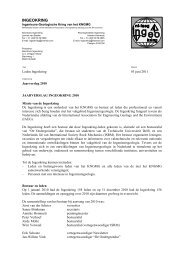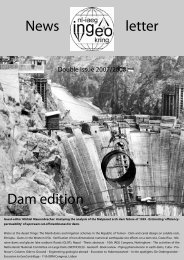environment
environment
environment
- No tags were found...
You also want an ePaper? Increase the reach of your titles
YUMPU automatically turns print PDFs into web optimized ePapers that Google loves.
Vol. 11 No. 1 2004<br />
natural resources has become a real challenge. The<br />
livelihood of the rural population has improved<br />
significantly during the past 20 years; most villages<br />
have improved access to health, educational and<br />
agricultural extension services but some 30 percent of<br />
rural households may remain vulnerable, with<br />
consumption levels close to the poverty line.<br />
Rural-urban migration is a serious problem. A majority<br />
of Bhutanese live in rural areas but about 20 percent of<br />
the population now lives in urban areas. Centres like<br />
Thimphu, the capital with a population of almost 50,000,<br />
and Phuentsholing, the most important border post for<br />
goods flowing to/from Bhutan, have been growing very<br />
fast recently.<br />
Economic development through rural access<br />
One of the keys to economic development of the country<br />
is the provision of an efficient and cost-effective<br />
transport system for freight and passengers. This is<br />
particularly important in the context of Bhutan's difficult<br />
physical <strong>environment</strong>. The country is land-locked and<br />
almost entirely located in the various mountain ranges<br />
of the Himalayas (see figure 1), which makes it highly<br />
dependent on transport for its international trade, and<br />
makes the provision of domestic road transport links<br />
difficult, especially in the north of the country.<br />
Because of the mountainous terrain, with altitudes<br />
between 200 to 7500 meter, the area of land suitable for<br />
agriculture is very limited and the population is<br />
distributed in remote scattered settlements. The above<br />
factors make the construction and maintenance of roads<br />
and the delivery of health and education services<br />
extremely difficult and costly.<br />
The Royal Government of Bhutan's (RGoB) series of<br />
Five Year Plans (FYP) have since 1961 therefore placed<br />
strong emphasis on improving the country's transport<br />
infrastructure, and one of the most important results is<br />
a road network that has now been extended to cover all<br />
of the main towns and valleys.<br />
Bhutan has about 3,800 km of road network at present,<br />
but many rural communities are still cut off from the<br />
road network and depend on animal and head-load<br />
transport. In about one-third of all Geogs (Blocks), no<br />
part of the Geog is connected to feeder roads, and in<br />
another one-third only few parts are connected to them.<br />
In this situation, farmers remain dependent on<br />
subsistence agriculture, with no access to markets or to<br />
the education and health care services that have been<br />
provided, and there is a need to expand the national<br />
road network to enhance their lives.<br />
At the same time, travel on the National Highways<br />
remains slow and costly, and existing roads may have<br />
to be upgraded or improved. Maintenance of the existing<br />
infrastructure is an equally important component of the<br />
development and management of the road system.<br />
Priorities for the next 20 years therefore include both<br />
the further development of the national trunk roads and<br />
of the network of district and feeder roads, and the<br />
expansion of access to rural areas and to vulnerable<br />
groups through power tiller and farm roads.<br />
The Middle Path<br />
Bhutan has realized the possible problems that could<br />
be caused by uncontrolled economic development. It<br />
has also recognized the importance of sustainable<br />
development with its fragile mountain ecosystem and<br />
extremely rich bio-diversity. Accordingly, Bhutan has<br />
chosen the "middle path" where economic development<br />
should not take place at the expense of natural resources.<br />
The Environment Assessment Act, 2002 approved by<br />
the National Assembly, ensures that <strong>environment</strong><br />
assessments are conducted for all development<br />
activities that have potentially significant <strong>environment</strong>al<br />
impact.<br />
Road projects are one of the largest land users in the<br />
country. Inadequate road construction techniques have<br />
a significant impact on the <strong>environment</strong> and on<br />
sustainability. Road projects can therefore only<br />
commence upon receipt of an <strong>environment</strong>al clearance<br />
from National Environment Commission. The<br />
implementation of the recommendations of the<br />
Environment Assessment are monitored at site and<br />
penalties imposed wherever lapses have been noted.<br />
The Ninth Plan therefore also states that all road<br />
construction activities will be required to adopt<br />
<strong>environment</strong>ally sound techniques and conform to the<br />
Environmental Code of Practice for Highways and<br />
Roads.<br />
The EFRC Support Project<br />
In the end of 1999 SNV Bhutan started its support to<br />
the Department of Roads for the implementation of a<br />
World Bank credit for the construction of 122 km of<br />
feeder roads. Since <strong>environment</strong>al friendly road<br />
construction (EFRC) techniques were still absent in the<br />
country the project focussed on the development of<br />
such techniques and on creating an enabling<br />
<strong>environment</strong> for EFRC. In 2002 SNV Bhutan, with<br />
support from the Sustainable Development Secretariat<br />
(bi-lateral funding from The Netherlands), decided to<br />
continue it's support to further develop and introduce<br />
the EFRC concept and to further strengthen the<br />
capacity of the Department of Roads and other actors<br />
involved. For this purpose the EFRC Support Project<br />
25




